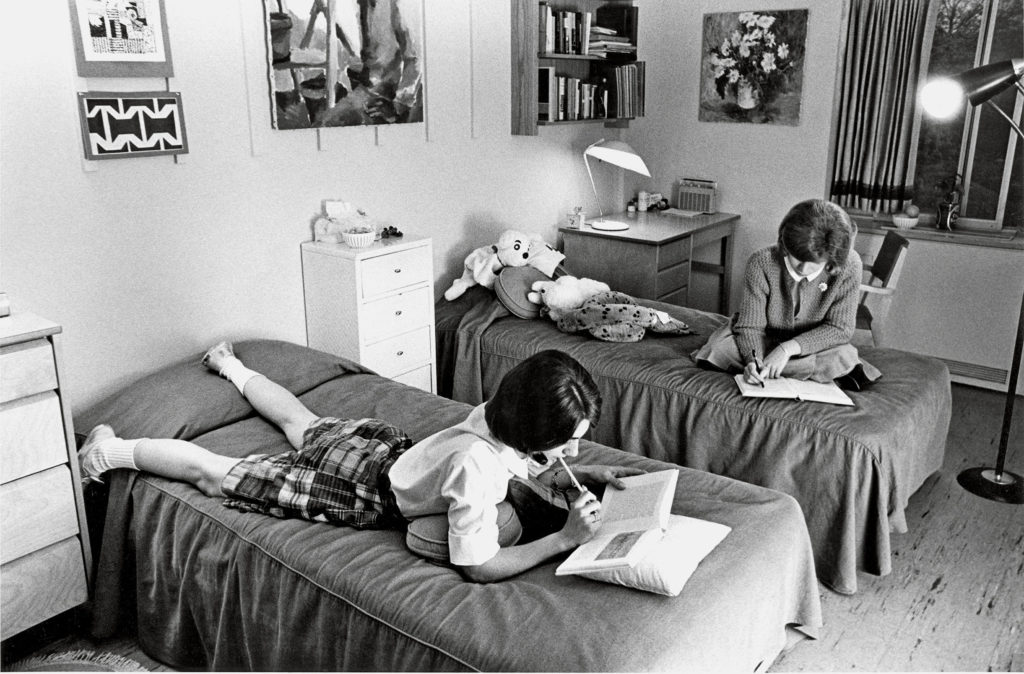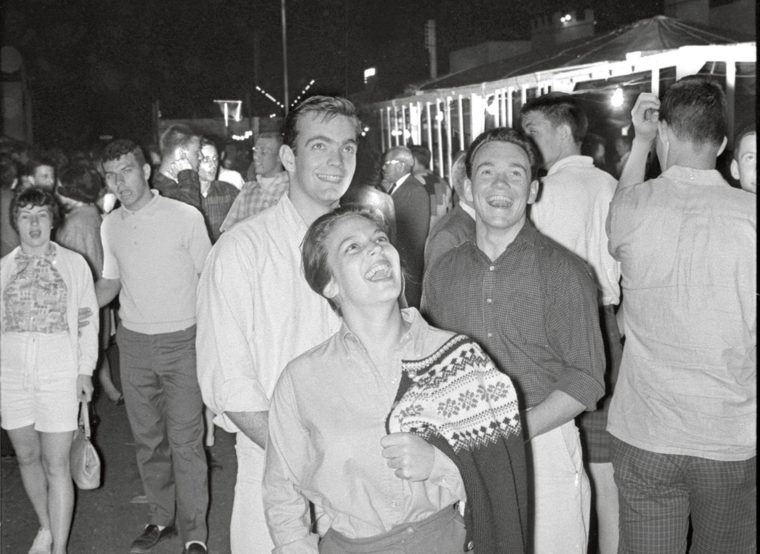The Class of 1966 arrived on campus during a time of great growth and change for Washington University. As incoming freshmen in 1962, they were the first class under the leadership of the 12th chancellor, Thomas Hopkinson Eliot. The university was increasingly attractive to out-of-state students, and by 1964, about 67 percent of entering freshmen came from outside the St. Louis area. Several new dormitories south of Forsyth were completed in 1962 to accommodate the growing need for housing. The new John M. Olin Library was also completed that year and quickly became a popular location for students to meet and study. In the winter of 1963, the last streetcar to campus stopped running, bringing the university’s reputation as a “streetcar college” to a symbolic end.
The United States was also experiencing a great deal of change in the fall of 1962. President John F. Kennedy was finishing his second year as president, and the Cuban Missile Crisis was gripping the nation. The United States was in the midst of the Space Race, and President Kennedy had recently announced plans to send an American to the Moon. The civil rights movement was in full swing, and civil rights activist James Meredith enrolled as the University of Mississippi’s first African-American student in October 1962.
Even with all of the national and international developments and tensions, Bill Finnie, BS ’66, recalls that time period as idyllic. “Our college years didn’t reflect what people generally think of when they think of ‘the ’60s.’ Jack Kennedy had just been elected president, and it was an idealistic time — before the student demonstrations came along.” In contrast, Bill’s wife, Glenda Lewis Finnie, AB ’66, remembers the mood on campus immediately following President Kennedy’s assassination. “It was amazingly somber. It was as if a blanket of sadness had fallen over the entire campus. We all were in disbelief,” she says.
Luckily, the Class of 1966 had plenty of opportunities for distraction from politics and current events — Thurtene Carnival, Bearskin Follies, Greek Sing, campus concerts, dances, films, the Washington University Choir and Madrigal Singers, and intramural sports were all popular with a wide cross-section of students.
Nancy Spirtas Kranzberg, AB ’66, recalls performing with the university choir under the guidance of Choir Director Orland Johnson as some of her most treasured Washington University memories. “The choir tours were wild and wonderful, and singing in Town Hall in New York was the tops!” she says.Performing in plays and writing skits for Bearskin Follies and Thurtene were favorite activities for many students, including Marilyn Dann Steinback, AB ’66, who minored in drama. “Being able to write entertaining and competitive skits was a sought-after skill on campus at that time. I remember working on a Bearskin skit with Harold Ramis (AB ’66) and Michael Shamberg (AB ’66) and just sitting in awe of their talent and creativity. I knew right away they were geniuses,” Steinback notes.
Students often gathered to socialize off campus too. Santoro’s was a convenient and popular hangout, as well as the Puppet Pub. In the early ’60s, the campus cafeteria in Wohl Center was closed on Sunday evenings, so students would walk to the Parkmoor Restaurant or The Flaming Pit for dinner. The Hilltop Campus — as it was known then — did not have all of the student-centered social and dining spaces that students on the Danforth Campus enjoy today.
Women living in the dormitories followed strict curfews in the early 1960s. “There was a reception center,” remembers Glenda Finnie, “and that was the only way to access your dorm room. You had to check in by a certain time, and if you accrued too many ‘late minutes,’ you were penalized. So we tried very hard not to hit that number!” Steinback remembers it clearly: “When curfew approached, everyone with their dates would be kissing and carrying on in the lobby. It was an uncomfortable scene at best!” By 1966, the curfews in one South 40 dormitory had been relaxed, and female students were allowed to determine their own dormitory rules, curfews and men’s visiting hours.

It may be difficult to believe now, but for the Class of 1966, smoking cigarettes was permitted virtually everywhere on campus — on the Quad, in dorm rooms, even in classrooms. “You could light up a cigarette in the middle of class, and it was not a big deal,” Bill Finnie says. “Glenda and I met as sophomores, and she was impressed by the smoke rings I blew in English class,” he recalls with a laugh.
The absence of personal computers might be equally difficult to imagine, but students who attended Washington University in the early ’60s did not have the convenience of Microsoft Office. They hand-typed their midterm papers. “Skilled typists made a lot of money at the end of the semester by typing papers for their classmates,” says Martha Wohler Bickel, AB ’66. “And if you had to make a change or addition, you had to pay to have the entire paper retyped!”
In 1963, Time magazine described Washington University as one of four “Take-Off Universities.” Members of the Class of 1966 have taken great pleasure in watching the university receive increased recognition from the media and rise in national rankings over the years. “When I attended Washington University, it was in the midst of a transition from being a ‘streetcar college’ to the ‘Harvard of the Midwest,’ a respectable backup for students who weren’t accepted at Ivy League schools,” says Scott Homan, BS ’66. “Now, the university is often the top choice for talented students across the country and the world! I feel privileged to have received such a premier education, and I am thrilled to attend our 50th Reunion, May 19–21.”
Laura Josehart is associate director of Development Communications.
